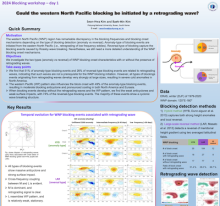Could the western North Pacific blocking be initiated by a retrograding wave?
Seon-Hwa
Kim
Pukyong National University, Busan, South Korea
Poster
Retrograding Rossby wave is well reported in the literature especially over the western North Pacific (WNP) where the zonal wind speed of jet becomes relatively weaker compared to other regions. The WNP region also exhibits different types (anomaly vs. reversal) of blocking and diverse frequencies of occurrence. Our study focuses on the influence of retrograding waves on winter WNP blocking initiation using EOF-based method applied to 500-hPa geopotential height at intermediate-frequency (fluctuations within the 6-30 days period) from 1979 to 2016, suitable for retrograding wave detection. We found that 54% of anomaly-type blocking events and 25% of reversal-type blocking events are associated with retrograding wave. This means that retrograding waves are not necessarily required to initiate blocking in the WNP. However, when retrograding waves are involved in blocking onset, blocking anticyclones of all types tend to develop very strongly and occur for a long time. Beyond retrograding waves, low-frequency variability known as the western Pacific (WP) pattern also influence the blocking onset in the WNP, resulting in relatively weak blocking anticyclones and moderate ambient surface warming. Furthermore, the blocking events that developed without the influence of the retrograding wave and WP pattern manifest as very weak anticyclones with comparatively shorter durations. Our findings aid in predicting the timing and intensity of WNP blocking based on the presence or absence of retrograding waves.

Poster file
Meeting homepage
